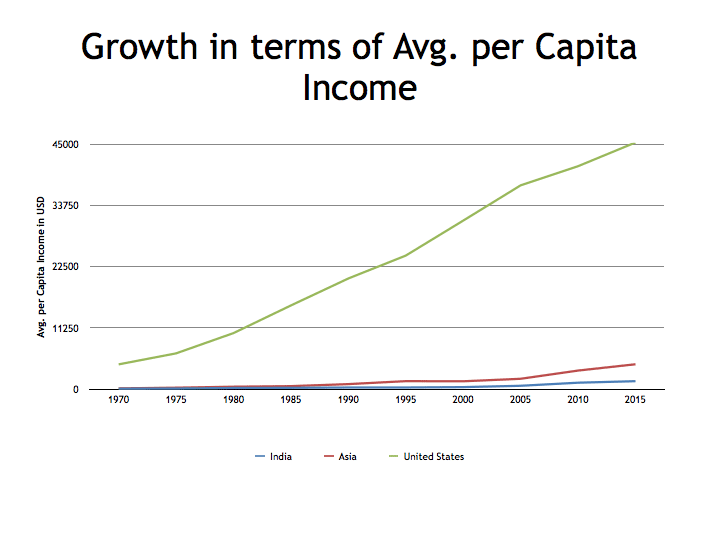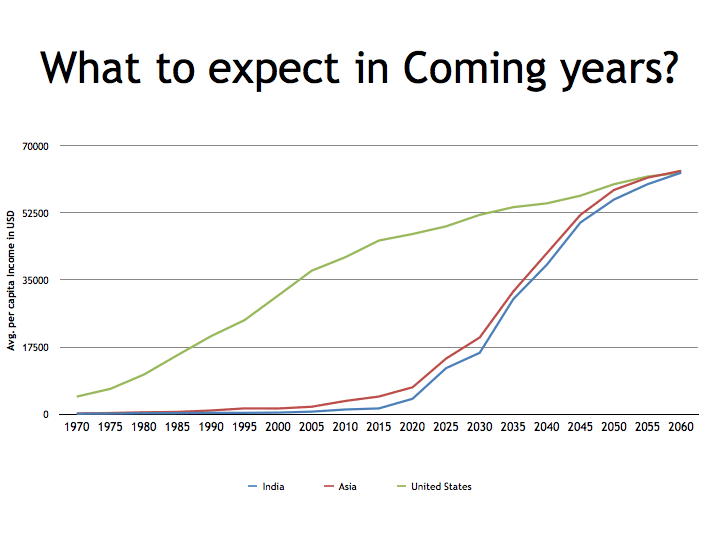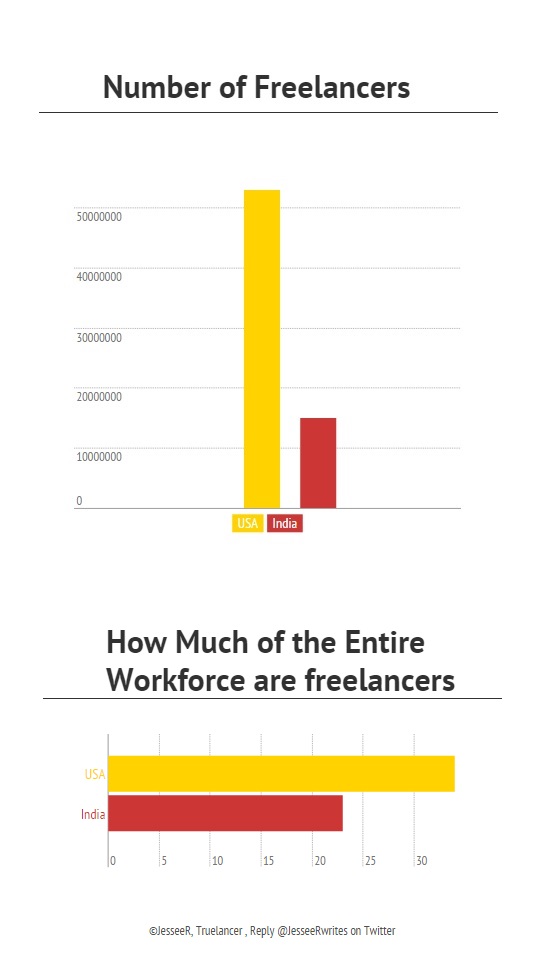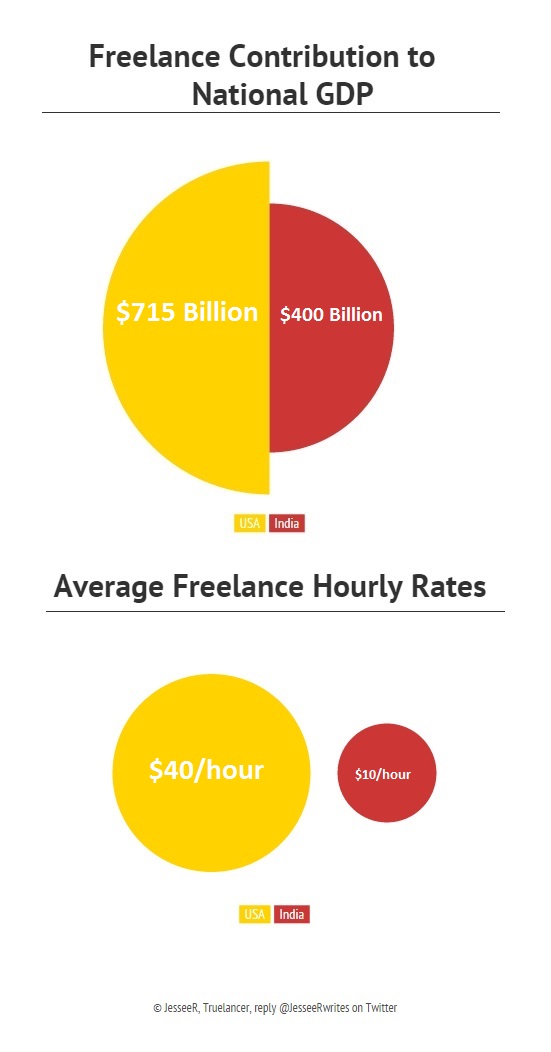Comparing Freelance Economies: India and the USA
With the sudden rise in Asian Pacific Freelancing, we have seen an exponential rise in freelance activity on Truelancer. This is based both on transactions and activity. This is evident in the economy too as freelance contributions to the GDP of these countries are reaching substantial amounts each day.
- Freelancers in India
- Freelancers in Pakistan
- Freelancers in USA
- Freelancers in Bangladesh
- Freelancers in the Philippines
- Freelancers in Kenya
- Freelancers in Sri Lanka
- Freelancers in Indonesia
- Freelancers in Brazil
- Freelancers in United Kingdom


This gives us an opportunity to know exactly how and where we stand when it comes to the quality and extent of our freelancing and also estimate the future course on which we are. For this, we need to compare our current statistics with that of those nations which are also developing their freelance sectors and those which have grown above the nascent phases of freelancing and already established working freelance management systems.
We need to start comparing freelance economies and look for significant data.
Thus, in this series we set out to explore the vital freelance stats of India against that of Singapore, USA, Asia and finally the entire globe and chalk out the impending opportunities and possible courses of action that Indian Freelancing can take.
In this post, we are comparing freelance economies of India and the USA
- What is the extent of Freelancing?

As the infographic shows, there is a substantial gap between the extents of activity in these freelance economies. But what is hidden in these charts is the fact that Indian freelance is rising rapidly. If we would have seen the same stats from the past few years we will find out that the gaps were far more.
Currently, there are 53 million American freelancers as compared to the 15 million Indian freelancers. This does not mean that freelance benefits are not enough as we can see that 25% of the entire Indian workforce is actively freelancing. This is still low compared to the 34% of the US workforce but given the whole population of the Indian Workforce, it is clear that the numbers are still substantial.
- What are the monetary and other benefits?

We can clearly infer from the infographic that freelancing is still considered a new kind of profession in India and thus falls short of its contribution to the national income as well as the average payout criteria.
One must know that freelancing is not just limited to online activity. It also includes sole proprietors and independent contractors who work on their own. That is why the gap between GDP contributions of these freelancing economies is less wide than that about what they earn.
We see that freelancers in India earn on average $10 and hour which is a very optimistic estimate while Freelancers in the USA earn an average of $40 an hour which mind you is a pessimistic estimate. Thus, the gap of income is large.
This is hugely based on two factors. First is that most of the freelance work are outsourced through multiple channels. This leaves little for freelancers as most of the good money are diverted to intermediaries. The second factor is the prevailing mind set of the market which still believes that organized and long term work has no alternative. Thus, freelancers are often looked upon as a cheap option.
This is one area where we need to work on. Freelancers in India are providers of quality work as can be seen from the laudable feedback and endorsements our freelancers generate on Truelancer. Thus, the need of the hour is to create more scope for freelancers and increase their competitive market potential which we are always focussing on.
- What is the reason for doing Freelancing?

Most of the reasons for turning to freelance are quite common amongst both countries. It can be seen that the same cycle of development leads to such changes in work ideology. The USA saw its freelance boom towards the end of the 2008 recession as people started to diversify their risks while India has seen a freelance boom after the numerous economic fiascos by the previous government. Thus, the scenarios have been similar and so have been the reasons like:
- Multiple channels of income
- Extra Income Potential
- Networking and Contacts
- Self-independence
- Increased creativity and work satisfaction
- Self-employment opportunities
- Increased freedom and work comfort
We see that most of these reasons are self-explanatory. They all although point in the direction that reveals a trademark shift in ideology which workforce’s have seen in the recent times. Empowering oneself with the capabilities of self-independence and self-employment seem to be the idea of the day.
- What is the extent of satisfaction?
Although the financial component of the freelance workspace is low in the beginning, people seem satisfied with their work in both countries.
In the states, more than half of the freelancers are satisfied with their earning potential while this number is around 40% in India.
This satisfaction is not based on finance but on the quality of life and its independence quotient.
Freelancers see it as a chance at something great. They see office work as limited and restricted while freelance provides them with an opportunity to build a strong and large work network with a global clientele. The future potential of exponential success and better quality of life is what draws most people to freelancing in both countries.
Although, we would like point out that in India the focus on money is slightly more than that in the States. This may be because of the developed and developing nature of the countries as people in the latter are inclined towards financial freedom.
- A final summary
In the end, it is quite conclusive that it will take time for Indian freelancers to earn as much as those from the states. For this, there will have to be trademark changes in strategy and planning which Indians will have to employ. For instance, we as freelancers should aim to remove the intermediaries between us and clients. This way we can generate more income for quality work.
At Truelancer, we see a spike in freelance activity each day which is higher than the previous day. This means that the jump in freelance activity as far as India is concerned is on the rise. Therefore, we realise the opportunity to provide Indian freelancer with a robust platform where their capabilities are utilised in the most optimum manner.
Next in the series, we will compare the Indian freelance economy with another major Asian freelancing nation – Singapore. Stay tuned for updates.
Haven’t tried Freelancing yet? Signup on Truelancer today and start earning doing freelance part-time Jobs.
A passionate Blogger and Digital Marketer

Pingback: Empowering freelancers in India: why we developed the Indian Local Bank Transfer Withdrawal feature()
Pingback: The Top 3 Countries To Outsource For English-Based Roles | EJOBS Outsourcing()
Pingback: The Top 3 Countries To Outsource For English-Based Roles | EJOBSアウトソーシング()
Pingback: The Top 3 Countries To Outsource For English-Based Roles | EJOBS Outsourcing()